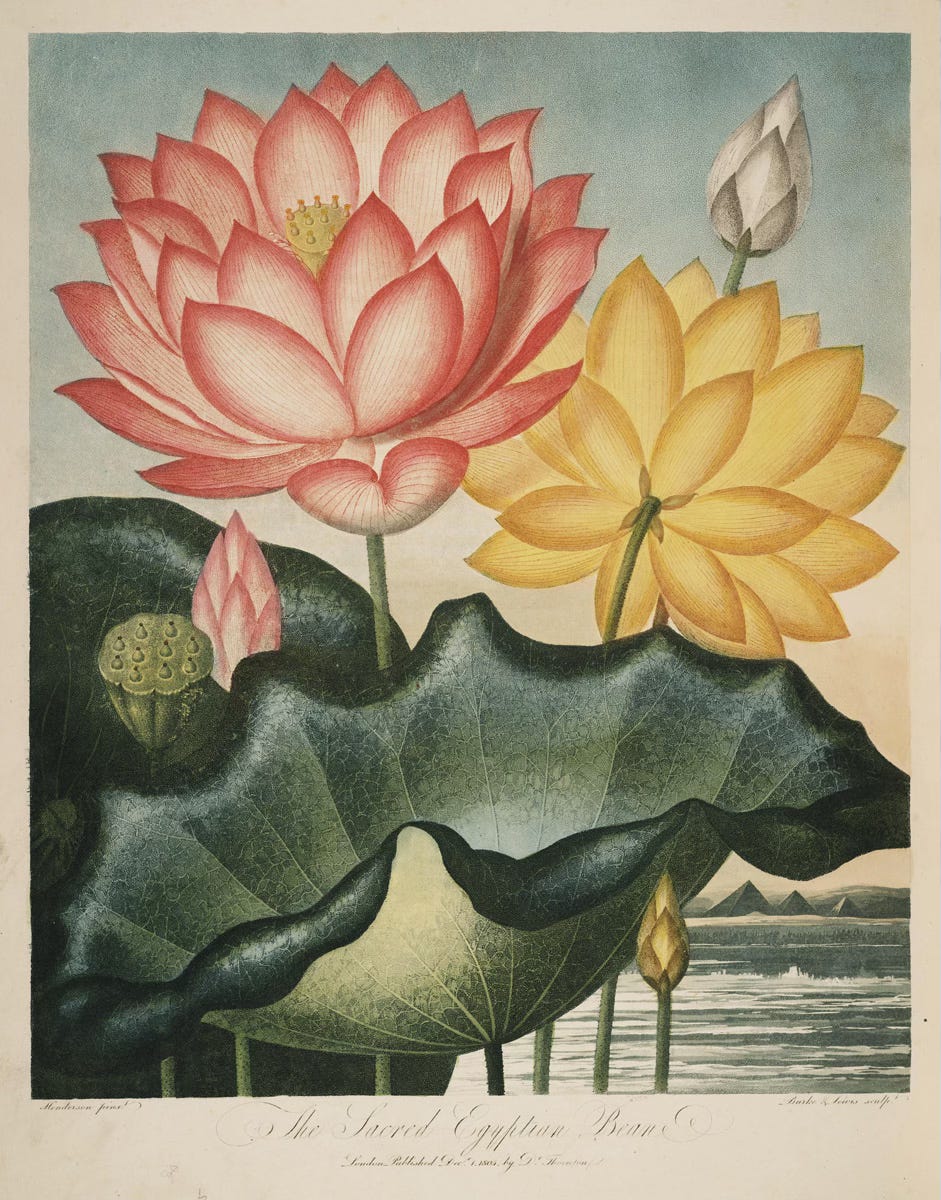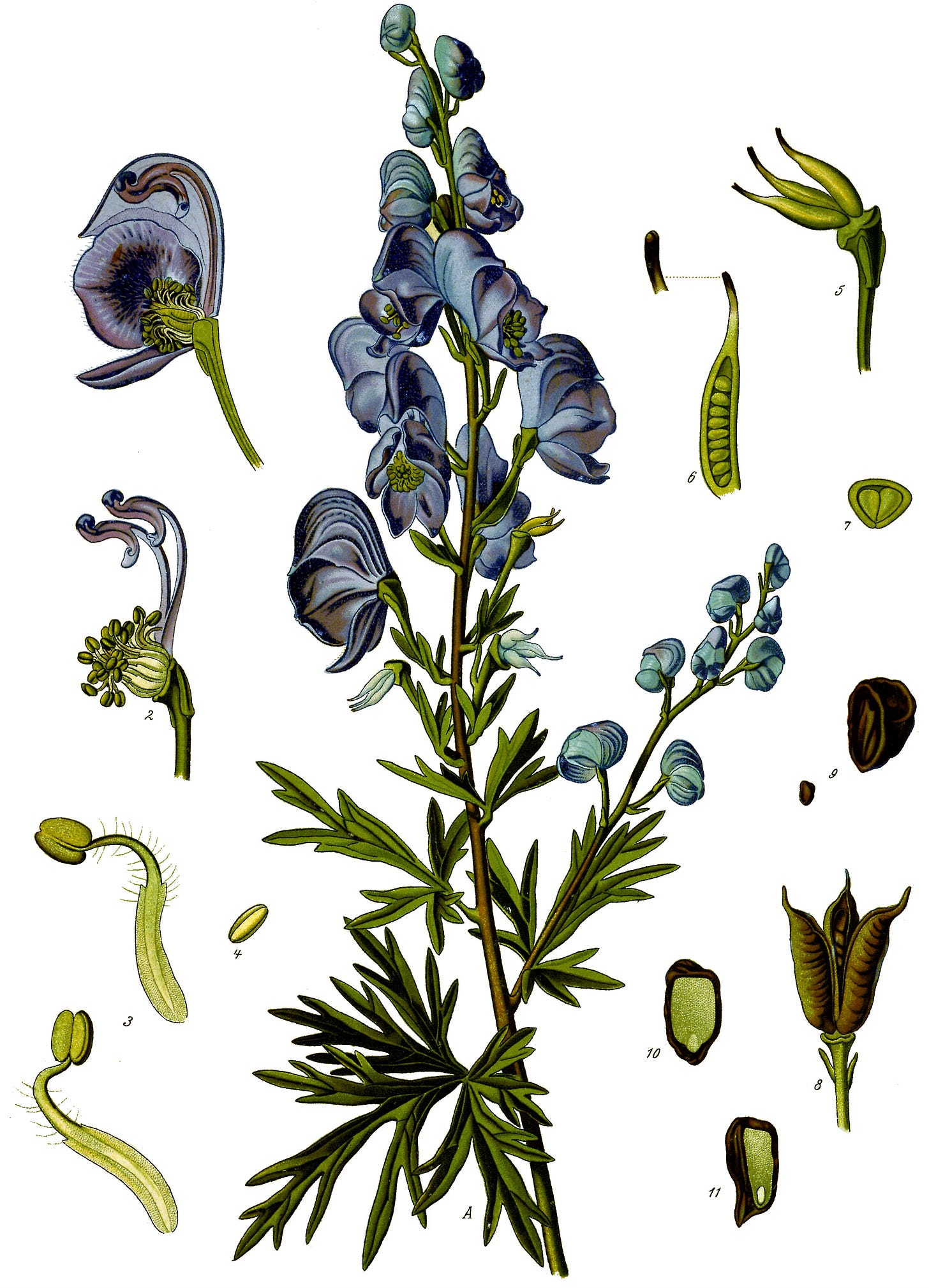The Freaky Folklore of Flowers: Spring is coming but things can still get sinister...
Wolfsbane, Mandrake and a Lotus blossom so good you forgot where you live.
Welcome to LOST IN FOLKLORE, where I take a lighthearted look at elements of folk stories, fairy tales, myths and monsters. If you’ve arrived here by accident and want to unsubscribe, please do. It helps make sure everyone on this quest wants to be here.
Oh, I did mention it’s a quest, right? Umm…forget I said anything.
Just watch out for the haunted root…
Aconite
You might think you’re a badass for owning a Venus Fly Trap, but you’d be hard pressed to match the menace of this plant.
According to Ovid’s Metamorphosis, Aconite sprang from the saliva of Cerberus, the three headed dog that guards the underworld.
This all happened during Hercules’ (Heracles) twelfth and final labor: to capture Cerberus and bring him to the outside world. Legend has it that Cerberus, who had never before seen sunlight, promptly began to drool a poisonous foam and where it landed, Aconite grew.
As befits a plant that emerged from demon dog slobber, Aconite has been considered to hold a dark and dangerous power since the time of antiquity. It’s alleged to be the poison Medea used to try to kill Theseus and it’s closely linked to Hecate, Greek Goddess of magic and witchcraft.
Also known as Wolfsbane, Monkshood, Devil’s Helmet and the Queen of Poisons, you know you’ve got some malevolent flora on your hands when all of its names double as heavy metal bands. (Just don’t tell anyone it’s part of the Buttercup family). And indeed, if you ingested its roots you’d likely die of a heart attack, while its leaves will, at the very least, give you a nasty case of the trots.
While Monkshood and Devil’s Helmet refer to the shape of the purple flower, the name Wolfsbane may have come from the idea that the plant’s juices could have been used to bait and poison wolves, or just that wolves ate the plant and then suffered.
As legends do, this story morphed during medieval and renaissance times into tales about Werewolves, including myths that the plant could transform someone into a Werewolf or cure them of the affliction. So, like an early version of hair of the dog, if you will. (And even if you won’t. It’s my newsletter after all.)
One thing is certain: if you have this bad boy growing in your garden, don’t, whatever you do, mistake its root for a Jerusalem artichoke or things are likely to get beastly.
Lotus Flower

The Lotus flower shows up in mythology around the world.
In Egypt, it is said to have given birth to the Sun God Ra, because of the way the lotus closes at night and reopens at dawn.
In Buddhism, the flower stands for purity, enlightenment and new beginnings because of the way that it floats above the murky waters.
These days, the term Lotus Eaters refers to people who spend their time indulging in pleasure rather than dealing with the practicalities and realities of life. (Although these days who could blame us?)
But do you know where that phrase originated? It was Homer’s Odyssey.In the epic poem, Odysseus and his men stop at an island on their way back to Ithaca after the Trojan War. The island’s inhabitants offer some of the crew the fruit of the lotus flower, but as soon as the voyagers consume the fruit they forget their desire to return home, instead yearning to stay with the locals in a state of blissful indifference.
Coincidentally that is exactly how I feel after I eat the delicious soft noodles at the Lotus Flower Chinese Restaurant.
Odysseus has to handle the situation, physically dragging his crew away. “Though they wept bitterly I forced them back to the ships and made them fast under the benches.”
My other half confirms he can relate.
The story is later immortalised again by Tennyson's poem ‘The Lotos-Eaters’ but in this version, the travellers never return home:
Let us swear an oath, and keep it with an equal mind,
In the hollow Lotos-land to live and lie reclined
Which could have been my fate, except the restaurant closes at ten.
Mandrake Root
I’ll wait while you stop shuddering. Done? Lovely.
Introducing The Mandrake Root, a plant with a face only a mother could love and a body that…well, let’s just not go there.
The plant and its freakishly humanoid root have hallucinogenic, hypnotic and toxic properties and legend has it that, when pulled from the earth it uttered such a scream it would kill anyone who heard it. (Though, frankly, if I pulled this from the earth that murderous shriek would have some competition. )
The most famous story about the mandrake is that, due to the aforementioned killing shriek, the safe way to extract the root was, as retold by botanical gardens experts Kew.com, to “dig into the ground to expose the roots, draw three circles around the plant with a sword and tie a rope around a starved black dog and the mandrake; throw fresh meat to the dog, which will run towards it and pull the mandrake from the ground.”
The dog dies, one presumes, but you get your mandrake. (Possibly the dog got the better deal here.)
With purple bell shaped flowers and yellow fruit, the gnarly root of this plant was used as an anaesthetic during ancient times.
Mandrake was also an ingredient often cited in ‘flying ointments’, which were supposedly used by witches to gain hallucinogenic effects and which eagle-eyed readers will remember I mentioned in a previous post.
Because of its uncanny resemblance to the human form the root was also used by healers as a fertility aid. And In De Materia Medica, as well as talking about the root’s medicinal use as an anaesthetic and soporific, ancient physician Dioscorides also reputedly noted the root’s long association with ‘love philtres’ (love potions).
Though the relationship that would spring forth from one of these harrowing fellows really does not bear thinking about. I mean…is it just me or is this root cosplaying as one of the world’s creepiest ever paintings?
Brrrrrrrr.
Sweet narcotic dreams everyone.
Daffodils
After all that unsettling and dangerous stuff, maybe it’s time for something more upbeat.
And what is more positive than a daffodil?
Here in the UK, the sight of daffodils (okay, and mini eggs) is the sign we need that winter will soon be over, spring is on its way and - please God - we will get some sun before we wither away like the pasty wraiths the colder months have made us. (Just me?)
There are many myths and folklore about Daffodils.
In Wales the daffodils is the national emblem, traditionally worn on St David’s Day (March 1st) and Welsh legend has it that the first person to spot a daffodil in bloom will have a lucky and prosperous year ahead. While in China, it is said that if you have a blooming daffodil in your garden on Jan 1st, you’ll have good luck for the rest of the year.
But one of the most well known is the story of Echo and Narcissus. Echo was a chatterbox of a nymph who was punished by Hera, cursed only to be able to repeat what others say. Lonely Echo wandered the forest and chanced upon the handsome Narcissus. Of course she couldn't actually have a conversation with him, and he cruelly rejected her.
In Ovid’s telling, when Narcissus was born his mother consulted the seer Tiresias who said that the boy would have a long life, ‘If he does not discover himself'. So it’s bad news all round when Narcissus, having rejected Echo, then falls in love with his own reflection in a pool. Unable to wrench himself away, and with Echo still repeating his cries of love and anguish, he wastes away and dies there.
Ovid tells us that, when his sisters came to retrieve his corpse for the pyre they found instead: “a flower, instead of his body, with white petals surrounding a yellow heart.” He had turned into a narcissus aka daffodil.
Blimey.
Okay, maybe that story wasn't so optimistic after all.
Happy (almost) Spring!
Do try not to turn into a werewolf, a daffodil or a Lotus Eater, won’t you?
Enjoyed this post? Then you might also enjoy these other popular posts:
The fickle folklore of Valentine's Day 💔
Five Spooky Powers I'd Kill For. 🎃
Five weird Christmas myths: The naughty, the nice and the just plain nutso of festive folklore 🤶
Mushrooms and Toadstools and Fungi, oh my! 🍄
Okay, that’s all from me. See you next time. Byeeeeeeeee! 🌸










Who doesn't love a bit of scary plant lore? This just gives me the urge to visit the Alnwick "Poison" Garden (https://www.alnwickgarden.com/the-garden/poison-garden/)... I'll sate that urge one day!
Herbal folklore has to be my favorite lore, spiced your sass (that’s funny cuz it’s a tree) just makes it more to savior.